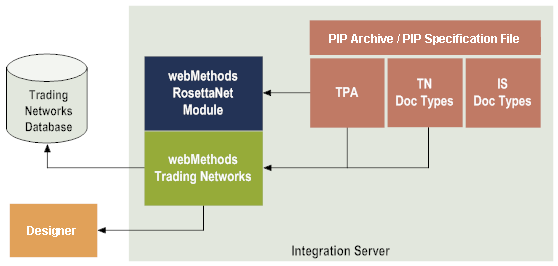

Component | Description |
PIP Archive/PIP Specification File | A PIP Specification File / Partner Interface Process (PIP) archive file contains the following: During design time, import the PIP archives you will use into Integration Server. |
RosettaNet Module | RosettaNet Module contains process model templates for the different types of PIPs that you can implement. You can use Designer to modify these process model templates as needed to create your PIPs. |
Trading Networks | Trading Networks links you and your trading partners to form a business-to-business trading network. Trading Networks uses trading partner profiles to determine how to exchange business documents with your trading partners. During design time, you define your trading partner profiles through My webMethods (the interface to Trading Networks). You can also customize the Trading Partner Agreements (TPAs) and view TN XML document types. TPAs and TN XML document types are created in Trading Networks when you import the PIP using PIP Tools or by importing a PIP archive file into Integration Server. |
Trading Networks Database | Trading Networks saves trading partner profiles TN XML document types, and TPA information in its database and retrieves this information when needed. |
Designer | Designer allows you to create process models and customize the process model templates provided with RosettaNet Module. When you customize a process model template, you can specify how the process model interacts with your back-end (internal) systems and specify the services to be invoked during individual steps in the process. When you build and upload a process model, the run-time elements (services, triggers, and Process Engine scripts, or fragments) are generated automatically. For more information about Designer, see the Software AG Designer Online Help. For information about customizing a process model template, see
Customizing Process Model Template. |
Integration Server | Integration Server contains the documents, services, and records that you can access when creating your process models. |